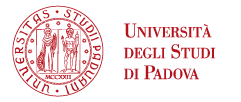Animal Science
Members
Lucia Bailoni, Paolo Carnier, Angela Trocino, Valentina Bonfatti
Research topic
Animal breeding and genetics: genome-wide association studies and development of genomic selection procedures in farm and companion animals; development and optimization of breeding programs, genetic evaluation of breeding candidates and procedures for breeding value prediction, control of inbreeding and definition of mating schemes, and use of crossbreeding; investigations on hereditary diseases in purebred dogs and organization of selective breeding procedures; study of “boar taint” in pig populations; analysis of variation in nutritional and technological properties of individual milk as affected by protein composition, fatty acid composition, mineral content and coagulation properties; development of innovative tools for large-scale phenotyping of animal populations using near and mid infrared spectroscopy.
Nutritional strategies to improve the quality of milk and reduce the environmental impact of farms with the aim to produce animal foods with high nutritional value, with regard to the fatty acid profile (omega 3 fatty acids, CLA etc.) and the content of antioxidant substances (selenium, vitamins a and E, etc.) and with a high level of food safety (i.e. control of mycotoxin contamination). An important topic of the research is the reduction of nitrogen excretion and methane emissions by the dairy cows and the study of the rations with low environmental impact. Other research lines are the sustainability of dairy herds with particular reference to organic production, the valorisation of typical food and the use of co-products in animal feeding.
Production systems, animal welfare and quality of products from small species (poultry science, rabbit science, aquaculture): with the final aim of contributing to a sustainable progress and change of the actual production systems, the research programs aim at improving production efficiency (performance, digestive health, slaughter results), animal welfare (behavior and stress) and product quality (rheological, chemical and nutritional traits; myopathies occurrence, post-mortem changes) through innovative nutritional and feeding strategies (energy and protein supply feed restriction, feed additives, alternative raw materials) and housing systems (micro-climate, types of cages/pens, environmental enrichment, alternative group housing systems).





